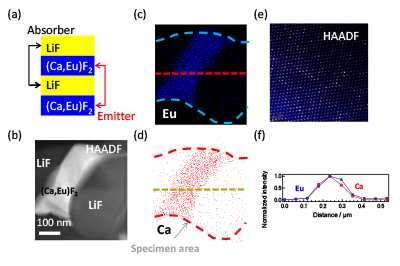Local Coordination State of Rare Earth in Eutectic Scintillators for Neutron Detector Applications − Design of Solid State Neutron Detection with High Sensitivity Alternatives to 3He Gas −
|
This research topics is based on the studies published in “Scientific Reports“on August 21, 2015. |
Assist Prof. Masai, H. |
||||
|
Assist Prof. Masai, H. (Division of Materials Chemistry, Inorganic Photonics Materials) |
|||||
|
Assist Prof. Masai, H. (Division of Materials Chemistry, Inorganic Photonics Materials), Prof. Yanagida, T. (NAIST), Prof. Mizoguchi, T. (The University of Tokyo), Dr. Ina, T. (JASRI), Dr. Miyazaki, T. (Tohoku Univ.), Dr. Kawaguchi, N. and Dr. Fukuda, K. (Tokuyama Corporation) examined local coordination state of rare earth in fluoride eutectics for neutron detector applications. |
|||||
|
Detector of ionizing radiation, including medical imaging, particle physics, security, astrophysics, and searching for natural resources, is one of the practical applications of phosphor containing emission center. Since 3He gas suffers a serious shortage by a large demands or security applications, the effort toward the fabrication of novel thermal neutron scintillators containing 6Li or 10B to replace the present 3He-based systems has been heightened. Recently, lithium-containing fluorides have attracted attention across the world as a high conversion efficiency attained by low phonon energy. Among these Li-containing fluorides, the activator–doped LiF/CaF2eutectic prepared by a simple solidification method is reported as a candidate for neutron scintillator applications. Although the actual distribution of the activator in solid state matter is a critical factor in attaining a high performance, it is not easy to observe atomic distribution of activator cations in fluorides because of low chemical durability of fluoride against electron beam observation.
The present work is expected to accelerate the study on fabrication of solid state neutron detector, and leads to the development of the future high sensitivity detector. |
|||||
|
Figure 1. Schematic image of Eu-doped LiF-CaF2 eutectics and the STEM images. Schematic image of the eutectic structure (a), STEM image (b) and the EDS mappings of Eu (c), and Ca (d). In Figure 1 (b), 1(c), and 1(d), (Ca,Eu)F2 layer exists between (Ca,Eu)F2 layers. The elemental mappings of each cation show that Eu cations are homogenously dispersed in CaF2 region without remarkable aggregation at the interface. (e) HAADF image of (Ca,Eu)F2 layer, and (f) comparison of the distribution of Eu and Ca along the dashed line in Figure 1 (c) and (d). Eu cations exist at Ca site in CaF2. |
|||||
|
Thermal Neutron Scintillator: For detection of thermal neutrons, 6Li or 10B possessing high interaction probability is needed in solid state matter. Because of lack of 3He gas, alternative thermal neutron scintillators have been studied all over the world.
X-ray Absorption Fine Structure (XAFS) Measurement: One of the spectroscopic analysis using high-energy synchrotron radiation beam of a large synchrotron radiation facility, such as SPring-8. By using this method, information about atomic distance or valence state can be obtained.
High-angle Annular Dark-field (HAADF) Image: One of the microscopy techniques for observation of constituent atom and atomic arrangement, with a resolution of 0.1 nm scale at the present equipment. |
|||||
|
This work was partially supported by the Collaborative Research Program of ICR., Kyoto University (grant #2014-31, #2015-40), and the SPIRITS program, Kyoto University. |
|||||
 Institute for Chemical Research, Kyoto University
Institute for Chemical Research, Kyoto University International Joint Usage Research Center
International Joint Usage Research Center
